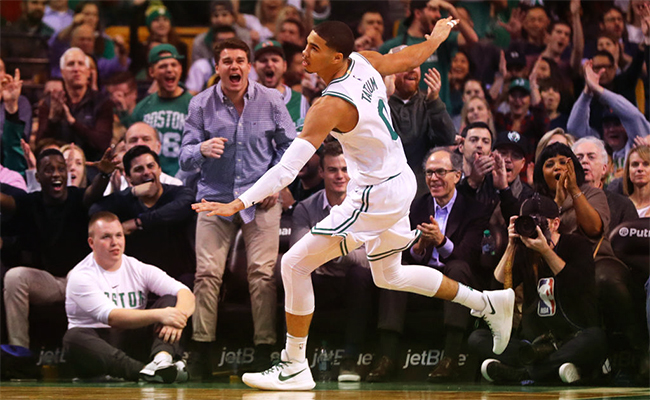
They’ve cooled down a bit lately, but the 2017-18 Boston Celtics have so far exceeded all reasonable expectations. After drafting Jayson Tatum, signing Gordon Hayward, and trading for Kyrie Irving, Las Vegas experts pegged the Celtics as a team that would finish in the mid-50s in wins. (Their preseason over/under was 54.5.) But even after losing Hayward to a fractured ankle just five minutes into the season, the Celtics have played at a 60-win pace.
They’ve been powered to their 28-10 record by basketball’s second-best defense, one which is itself powered by the roster’s enviable flexibility. And they use that flexibility to their advantage whenever possible. The Celtics, unlike most great teams, tend to shapeshift themselves to match their opponent on any given night.
Not including Hayward, Brad Stevens has used eight different players in his starting lineup this season. He’s rolled out those eight players in nine different five-man combinations across 37 games, with none of the configurations starting more than four consecutive games at any point. (For what it’s worth: eight of the nine lineups have .500 records or better, and seven are at .667 or better. The two highest-usage groups are 14-5 and 6-1, respectively.)
Some of the incessant maneuvering has been necessitated by injury. Stevens acknowledged that the team would have for the most part played small had Hayward stayed healthy; and that Marcus Morris’ various maladies which have limited him to only 17 games so far this season have thus prevented him from making regular appearances with the starting group. But even with those caveats, Stevens appears to like adjusting his lineup to match the opponent, rather than forcing the opponent to adjust to match the Celtics. If you have the personnel to play the opponent’s game — and if that personnel has the talent play the opponent’s style better than the opponent can — why not try?
“If Gordon was still available, we probably would be small almost all the time, if not all the time,” Stevens says. “But as a result, we think, obviously — when you’re playing against a team like the Knicks, for example, [Enes] Kanter is a guy that’s absolutely given us fits forever. [Andre] Drummond gave us fits with Detroit. The more we can have size on those guys, the better.”
Size typically means Aron Baynes. A 6’10 center who could pass for Tormund Giantsbane with a top-knot, Baynes came to Boston from the aforementioned Detroit Pistons this offseason. His 27 starts this year are already a career-high. His 18.3 minutes per game are as well, though not by quite as much. He says his experience with both the Spurs — for whom he made 17 starts in 70 games during the 2014-15 season — and the Australian national team prepared him for the lineup-juggling style of Stevens.

Asked if his preparation or playing style changes depending on whether he starts or comes off the bench, Baynes says simply, “Whatever the team needs at the time. Whenever my number’s called, I just go out there and try to play within the system. Coach always puts us in the right spot, so as long as we stick with that, we’re good.”
Baynes and his platoon-mate Marcus Morris both say they pretty much know ahead of time who’s going to start based on how the opposing team prefers to line up, so although Stevens will usually give them a heads-up either at shoot-around (if it takes place) or shortly before the game, he doesn’t really need to.
“It’s basically the center — how big the center is,” part-time starter Morris says. “When we’re playing against, like, Brook Lopez or Robin or DeMarcus Cousins or somebody like that, then we’re gonna probably put a bigger body on him.”
Unlike Baynes, however, Morris is firm in that he prefers to start. He’s not trying to rock the boat; it’s just that he thinks his talent level is that of a starting-caliber player. He’s also never been in a time-sharing arrangement like this before. He was a full-time bench player for the most part while in Phoenix, and then he became a full-time starter in Detroit. “It’s different. I can tell you that. It’s different. But that’s the philosophy that Coach Brad has, matching up with the other team. So, you know, it’s different.”
The only reason the Celtics are able to shift and change in this manner is because of the versatility of Al Horford. He’s the rare player capable of performing at equally high levels at both power forward and center without causing his team to sacrifice shooting or defense at either spot. And while there was near-constant consternation in certain corners of the basketball internet about what Horford’s “natural position” was while he was with the Hawks, he played more than 20 percent of his minutes at power forward only twice in nine seasons, according to Basketball-Reference. This season, though, he’s been there a career-high 34 percent of the time.
“It’s been fun. It’s just different challenges each night,” he says. “I don’t think there’s necessarily a lot of players that are able to do that or make that adjustment. And that’s one of my strengths that I feel like I’m able to bring. You might have a guy that wants to just bang down low, play in the low-post. Or you might have a guy you need to be chasing around the perimeter. Different things like that. There’s usually guys that can only do one of the two, but I feel like I’m able to do both.”
Stevens knows it’s a luxury to have a player like that, one that allows his team to play any which way not only on any given night, but any given possession or series of possessions. “He’s such a good player that it doesn’t matter,” he says. Stevens notes the usual things you hear about versatile players like Horford, that he can post-up smaller defenders and go past slower ones; and that he can prevent bigger guys from posting him and quicker guys from blowing by.
But Horford maintains that he’s not the only one with a versatile skill set that puts the Celtics in position to succeed. “I think Coach sees things a different way,” he says. “And I’d say it works pretty well for him. I mean, he’s pretty successful.”






